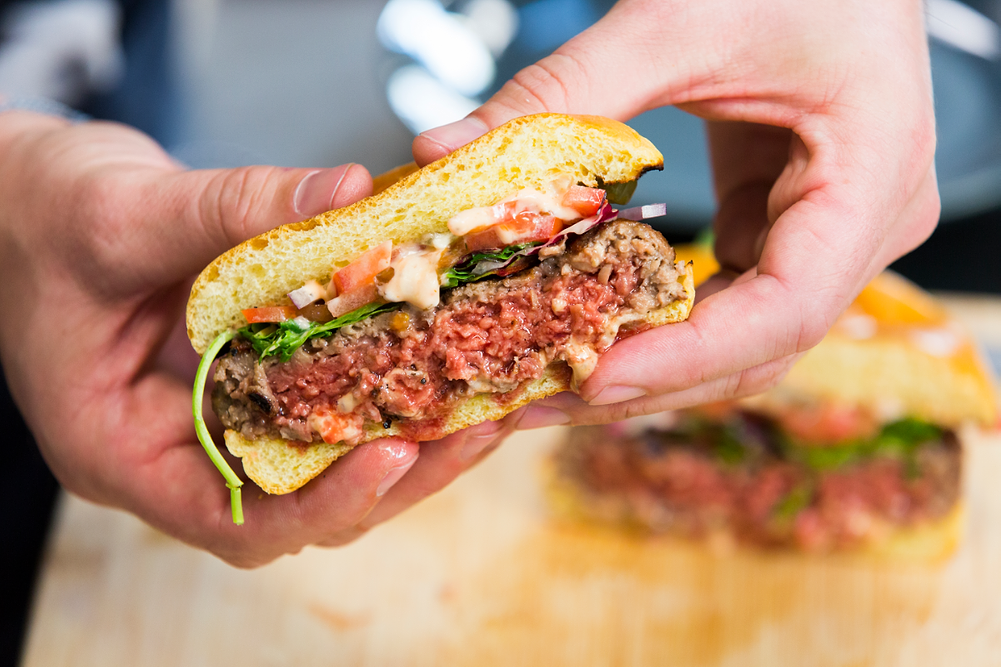KANSAS CITY — Biting into a hamburger is a simple pleasure: experiencing how the patty gives way on the first bite and how the juiciness overtakes the taste buds. Replicating that experience in plant-based alternatives is difficult. No matter the plant protein source, additional ingredients like hydrocolloids and starches may be required to achieve the proper texture.
Market research shows interest in plant-based burgers. London-based Technavio forecasts the global plant-based burger patties market will have a compound annual growth rate of 41% from 2020-24, and 53% of the growth will come in North America. Restaurant sales for plant-based meat substitutes jumped 87% in 2019, according to Buyers Edge Platform, a restaurant supply chain company. The company based its findings on the number of cases of meat substitutes ordered by its 20,000-plus restaurant customers in 2019 compared to 2018.
A word of COVID-19 caution came in late March from Suzy Badaracco, president of Culinary Tides, Inc., Tualatin, Ore. She said people may seek foods and beverages that provide comfort and familiarity during the pandemic. One example would be meat eaters who had tried plant-based burgers out of curiosity switching back to solely animal meat.
Flexitarians are consumers who are eating plant-based meat alternatives because they are reducing meat consumption. A 2019 survey from London-based GlobalData PLC found 5% of global consumers identify as flexitarian, which is the same percentage that identify as vegetarian. Flexitarians tend to seek meat alternatives that replicate meat’s texture, color and juiciness.
The proteins and fats in animal-based meat provide texture, structure, gelling, emulsification and color, said Melissa Machen, senior technical services specialist – plant protein for Cargill, Minneapolis. The proteins actin and myosin interact with salts for increased water-binding capacity and fat globules for emulsification and stability, she said. Myoglobin proteins contribute to color development and color stabilization.
“All those complex components combine to give meat products their distinct bite, chewiness, succulence and firmness,” Ms. Machen said. “Textured soy or pea proteins can provide a good foundation for product developers, but they’ll still need hydrocolloids like carrageenan to help with gel formation and water retention. Adding starches to binder systems can also help achieve the optimal balance between firm bite and juiciness.”
Soy protein, which has been used in meat alternatives for decades, still comes with challenges.
“When formulating with soy, textural issues can be present when ingredients are not complementary, are used in improper ratios or when the wrong type of soy ingredient is selected for the application,” said Shelley Rudisill, director of product development and applications, ADM Nutrition, for Archer Daniels Midland Co., Chicago. “For example, a plant-based burger incorporating soy ingredients with low water-binding capacity may fail to replicate the juiciness of a traditional burger.
“Selecting a soy ingredient with different functional properties, such as ADM’s textured soy protein concentrate in combination with a high gelling soy protein isolate, can increase water retention in the application, resulting in a juicier and more authentic texture.”
Ingredient lists for plant-based burgers are sometimes lengthy, even surpassing 20 ingredients. Using ingredients with multiple functionalities may shorten the list.
The ability of a single ingredient to simulate the taste, texture and nutrition of animal meat is not presently available, said Brock Lundberg, PhD, president of R&D for Fiberstar, Inc., River Falls, Wis.
“Texturized vegetable protein (TVP) is often used to enhance texture and nutrition,” he said. “However, other texturizing ingredients are needed for juiciness, binding, appearance, taste and strength of the meat alternative.”
Fiberstar’s Citri-Fi citrus fiber 100 series performs several functions in meat alternatives, including adding juiciness, sizzling during cooking, thickening oil and binding fat, Dr. Lundberg said.
“These attributes are a result of Citri-Fi’s abilities to hold large quantities of both water and oil, and these amounts or ratios of water and oil can be adjusted so that the amount bound and/or released during cooking targets the desired effect,” he said. “The second equally important function is for binding, strengthening and added texture, which can be done using the new Citri-Fi TX texturizing citrus fiber. Citri-Fi TX can be used to replace gluten and bind proteins together both during cold forming and cooking.”
Hydrosol GmbH & Co. KG, a business of the Stern-Wywiol Gruppe, last year set up a plant-based competence center at its headquarters in Ahrensburg, Germany.
“This is where we bundle all of our expertise around plant-based nutrition, trends, ingredients and food concepts in a creative pool,” said Florian Bark, product manager for Hydrosol. “Product managers, nutritionists, food technologists and marketing specialists use this expertise to develop creative concepts that address the trends in international markets and meet consumer demands.”
The company offers a HydroTop vegan patty modular system that has fava beans and peas as protein sources.
“During development we paid close attention to the ideal interplay of the individual ingredients, so that we could reduce the number of components to a minimum,” Mr. Bark said.





